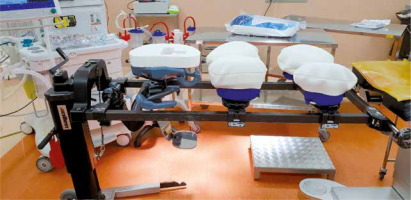Dear Editor,
Unintentional tracheal extubation in patients undergoing surgery while in the prone position is a dramaticand life-threatening event if it is not followed with rapid airway management [1]. Prone position is a problem for the anes-thesiologist who aims to treat such a case by turning the patient supine for tracheal re-intubation: such rotation in a supine position requires the time and support of personnel and may obviously contaminate the surgical field.
Laryngeal mask airway (LMA) has been reported as safe for patients with unintentional tracheal extubation under general anesthesia in prone position [2, 3]. Vertebroplasty and kyphoplasty are percutaneous techniques developed for treatment of vertebral compression fractures. The first one consolidates the vertebra by injecting cement into the vertebral body while the second one expands the vertebral body, prior to injection of the cement, in order to reduce settling. We report one case of accidental tracheal extubation in a patient undergoing surgical kyphoplasty of multiple dorsolumbar vertebrae compression fractures inducing severe back pain. The patient gave written informed consent to publish his case. The 86-year-old, ASA 3 male patient was scheduled for minimally invasive vertebral surgery. Anesthetic induction was uneventful; intubation with an armed tube (size 7.0) was checked before the patient was placed in the prone position on the orthopedic table including a mirror to detect ocular compression (Figure 1). Suddenly, in the course of surgery, the senior anesthesiologist observed a collapse of capnography and concluded briefly after glancing at the mirror that the patient was extubating. His oximetry pulse remained over 95 and before deciding to turn the patient supine for ventilation and tracheal re-intubation, he decided, with the help of a mirror, to insert an LMA (size 3): this maneuver was successful and the control of ventilation was assured with an adapted capno-graphy. Surgery was completed and the patient admitted to the Postanae-sthesia Care Unit (PACU), where he was extubated when awake. He was discharged on the second day without any sequelae. Such conditions remain rare but have to be reported to the anesthesiologist community. Prime insertion of a supraglottic airway device (SAD) following the induction in the prone position was reported in 1993 [2]. Prone insertion may be easy, as in the supine position, because the tongue is falling anteriorly and creates an opening for the placement of LMA and the risk of aspiration of regurgitant fluid is reduced due to gravity [4].In 2010, Abrishami et al. searched Medline and Embase databases, from 1980 to October 2009, in order to identify observational studies and case reports describing insertion of the LMA with the patient in the prone position [5]. They found 12 such articles (n = 526 patients): on the first attempt, the LMA was inserted successfully in 87.5-100% of the patients involved in the included reports. On the second attempt, the LMA was inserted successfully in all patients, with or without laryngoscopy. Ventilation was maintained successfully in the lungs of 83.3-100% of the patients. Following insertion of the LMA in the prone position, the most common complications reported were sore throat, bleeding, bradycardia, and laryngospasm [6]. In a recent study, forty anesthesia residents were asked to place in the airway trainer manikin (Laerdal) in the prone position three SADs: i-gel, LMA Proseal and LMA Classic. The authors found that although all three SADs were successful as rescue devices during accidental extubation in prone position, the ease of insertion was maximum with I-gel, which was characterized by less time taken for insertion [6]. However, the condition of insertion of the SAD is quite different in an emergency situation, and the expertise of the operator is very important. Training with a manikin for such conditions would have to be recommended.





